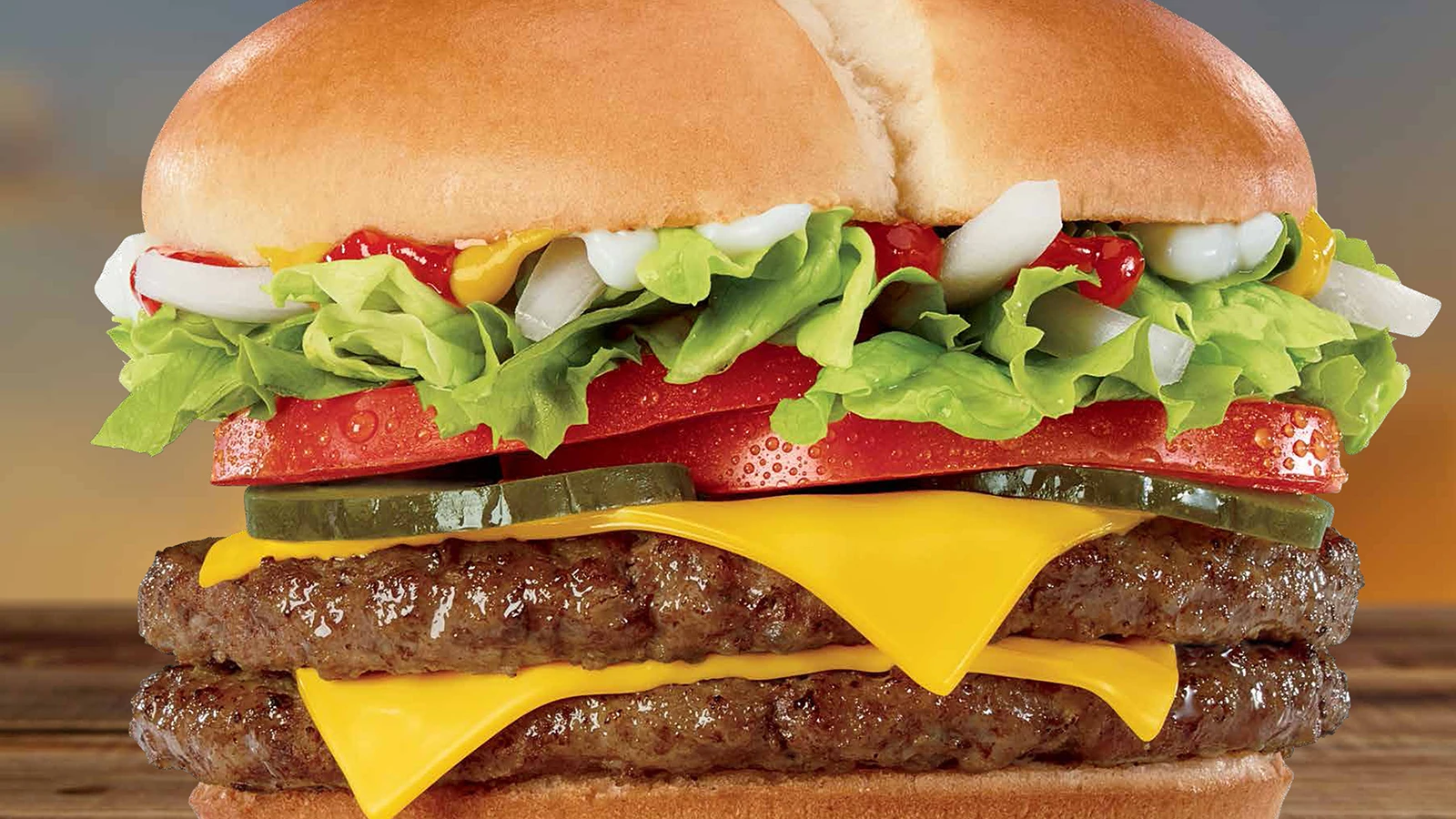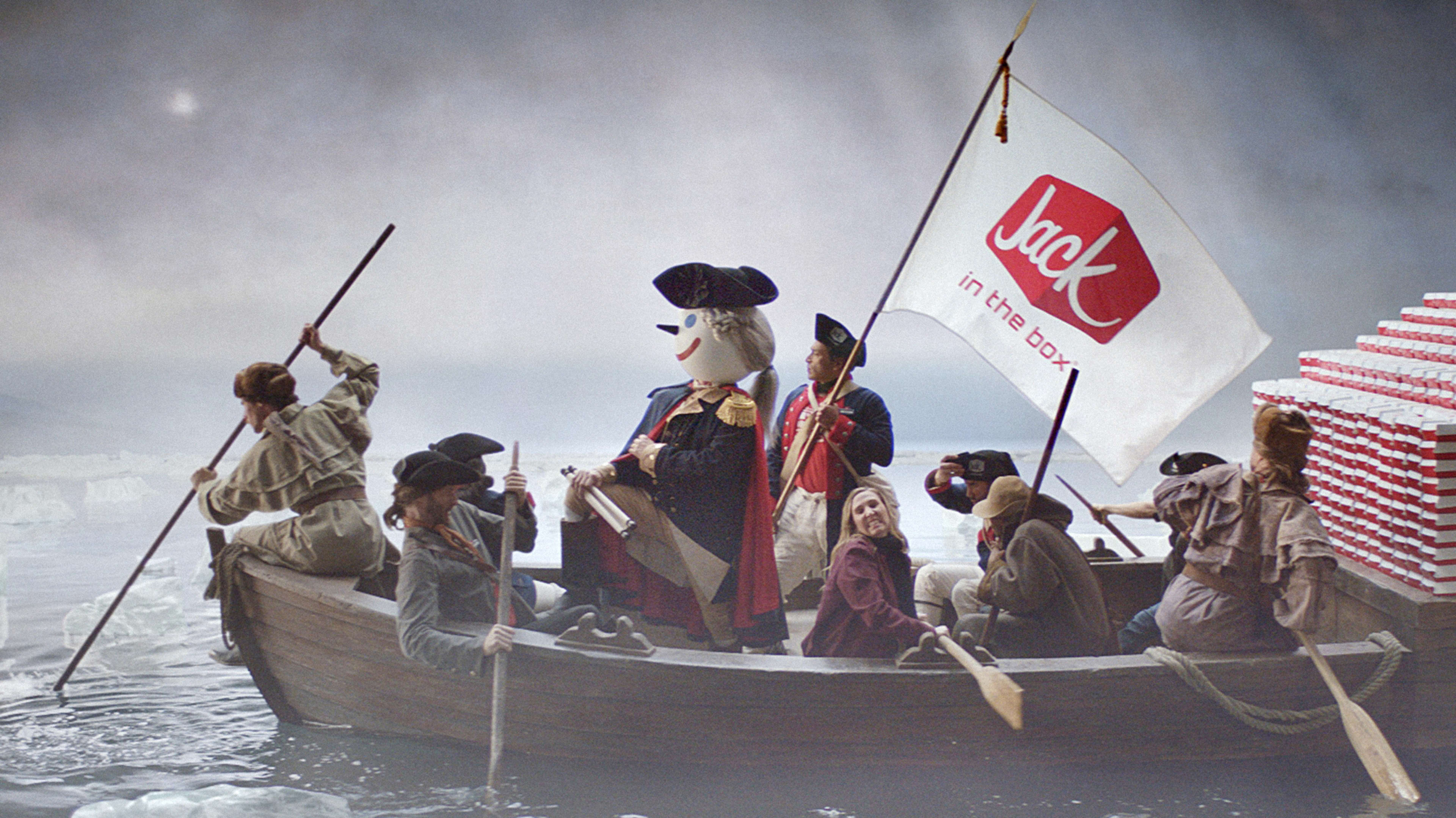When you walk into Jack in the Box’s corporate headquarters, two anonymous mid-rise buildings in a San Diego office park, the first thing you see is the branding. Jack, the fast food chain’s mascot and imaginary CEO, is everywhere. Jack has a parking spot outside the building. Jack appears on the wall decorations. Jack appears on signs for every room and office. Jack randomly pops up in the hallways. Jack owns the place.
And Jack’s chain is at a crossroads. As fast food restaurants go, Jack in the Box has a solid market niche. They’ve got a lock on junk-food-loving millennials thanks to items like their Buttery Jacks (cheeseburgers with a hefty topping of herb butter) and late night “Munchie Meals” (which include items like a hamburger with a grilled cheese sandwich for buns and a chicken-and-nacho chips sandwich), and the chain’s restaurants are a regular sight in the cities, suburbs, and small towns of the west coast. But Jack in the Box–whose corporate parent also owns Mexican chain Qdoba–lacks a signature item. As hard as they’ve tried, they’ve never created a Big Mac, a Whopper, or a newfangled breakout hit like Doritos Nachos Supreme Tacos.
So they did the natural thing: Create a massive, oversized burger and overhaul its core menu components.

The Quest To Create A New Burger
At the end of January, Jack in the Box is rolling out a new burger called the “Double Jack.” The sandwich consists of two quarter-pound patties, American cheese, lettuce, tomatoes, ketchup, mustard, pickles, and onions on a butter-toasted bun. The burger, whose name has already been trademarked by the brand, made its formal debut in a Super Bowl ad and is designed to highlight a long laundry list of changes Jack is making to their core product. The Super Bowl advertisement also revealed a much larger publicity stunt designed to promote the menu changes: A giveaway of one million free hamburgers from the fast food chain. Upon visiting Jack in the Box’s website, customers can sign up to have a coupon for a free Double Jack or Jumbo Jack burger sent to them by email or text message.
The Double Jack is at the center of a larger campaign called the “Declaration of Delicious” anchored around the Super Bowl ad. The Declaration of Delicious, which features (of course, and God bless them) a colonial-attired Jack named “Jack Washington,” is designed to introduce the public to much larger changes Jack in the Box is making to its menu.
That new buttered bun (inspired by the breakout popularity of the Buttery Jack?) is making its way to Jack’s other burgers and chicken sandwiches. The burgers are switching from heavily seasoned patties that are a miracle of modern food science to unseasoned 100% beef patties (with the exception of the Buttery Jack, which will have what the brand calls a “signature patty” whose non-100% beef nature is noted in advertising asterisks as seen below). The tomatoes and lettuce the chain uses are being tweaked. Jack in the Box’s marketing team tells me they’re even making the switch to real mayonnaise.
I asked Iwona Alter, JITB’s VP of product marketing and innovation, what Jack used before, if they are only now switching to “real mayonnaise.” Alter told me that it was “an onion-mayonnaise sauce before, that was part of our signature taste.” Real mayo, she added, works better with the chain’s menu changes.
A few minutes later, I bit into a Double Jack created by the hard-working team in the chain’s spotless test kitchen. It was delicious in a Platonic ideal of fast food kind of way and tasted exactly like something I’d happily (guiltily) eat on a long road trip. But changes to core menu items don’t happen in a bubble.
Breakfast And Burgers
In 2015, the biggest fast food industry development was McDonald’s launch of its all-day breakfast. When the global fast food giant decided to offer breakfast at all hours in the United States, it spiked demand for eggs from suppliers and coincided with a sharp rise in egg prices due to government regulation in major states such as California that required larger cages for egg-laying chickens. McDonalds’ decision to offer all-day breakfast was also a challenge for Jack in the Box, which has offered an all-day breakfast since the 1970s.
In an earnings call earlier this December, Jack in the Box’s real life CEO, Leonard Comma, told investors that his chain was focusing on hamburgers in response to McDonald’s breakfast expansion. The chain, however, doesn’t have a flagship burger. The Double Jack joins (at press time) two different Buttery Jacks, a Spicy Sriracha Burger, the Sourdough Jack, two different Ultimate Cheeseburgers, the Jumbo Jack, the Big Cheeseburger, and two smaller Junior burgers. There’s no clear flagship burger, but the chain is doubling down on the idea that a burger should exist for every conceivable taste and price point.
However, the kind of menu items they can offer are limited due to their loyal customer base. Keith Guilbault, the chain’s tireless CMO, told me that nearly 70% of the chain’s customers are drive-thru customers, and the customer base skews heavily toward millennials. The drive-thru issue, especially, determines the kinds of menu items that Jack in the Box sells: McDonald’s, Burger King, and Wendy’s all have much higher dine-in rates than Jack in the Box. Whatever new menu items the chain rolls out have to be friendly to in-car eating.
It also means catering to the customer’s whim. As Guilbault explained, the company’s stance is that “If you want a burger at 6 a.m., we’ll get you a burger.”
It’s All About Brand Identity
When I visited Jack in the Box’s offices, it was during a quiet period when the chain explicitly declined to discuss its financials. But it’s clear that the chain is in a state of transition. This past September, Jack in the Box switched ad agencies; Secret Weapon Marketing, who largely created the Jack Box character and helped craft the chain’s response to a disastrous 1993 E. coli outbreak, was dropped in favor of a new agency called David&Goliath. For a chain like Jack in the Box, which is tied to their mascot’s humorous commercials as deeply as McDonald’s is tied to Ronald McDonald, this was a massive change. Jack Box carried on as CEO, but no longer speaks in commercials–Dick Sittig, Jack’s longtime voice, is Secret Weapon’s founder.
According to a Jack in the Box representative, “Jack’s quiet at the moment, but that’s a product of the role he’s been playing and the recent journey he’s been on. In terms of where we go, Jack in the Box owns all rights to Jack’s character, including his voice. All aspects of his character are part of our consideration set for future marketing efforts.”
Although the company’s financials have been largely positive, with healthy earnings and revenue that increased 2.7% last quarter as compared to the same period last year, Jack in the Box’s stock was downgraded by analysts at TheStreet and Vetr in recent months. The San Diego office complex I visited also holds some of Qdoba’s offices; according to Guilbault, the two chains share offices related to accounting and support operations.
For Jack in the Box, the E. coli outbreak was a defining moment that nearly put the chain out of business. It resulted in four deaths and over 178 injuries including brain and kidney damage. The FDA adopted stringent new rules for the fast food industry as a result, and Jack in the Box–to its credit–completely overhauled its safety and food testing standards and rolled out a set of best practices which serve as a role model to other fast food chains. Food safety continues to vex the fast food industry; as I write this, Chipotle is dealing with a major food safety scandal of its own.
The very last area I was shown on my on-site visit was Jack in the Box’s in-house product safety lab, and Guilbault and public relations staff were very careful that it made it onto my tour. Even 20 years later, the food safety issue clearly remains on Jack’s mind.
However, the millennials who make up the core of Jack’s audience don’t define the brand by their 1990s scandal just as Tylenol buyers today don’t associate its brand with the 1980s dark days of tampered bottles and poisonings. Instead, the big brand definition challenge for Jack in the Box is satisfying those late teen and twentysomething buyers who can’t get enough of sriracha chicken and 1 a.m. tacos.

Enter The Butter Toaster
During my meal at the Jack in the Box innovation kitchen–a Double Jack with curly fries and a milkshake–I was also shown some of the equipment sent out to the chain’s franchises for the menu overhaul. Jeff Zwally, the chain’s vice president of culinary development, demoed one example for me: A “butter wheel” for their new buns which automatically bastes the buns with butter as they toast.
According to a Jack in the Box publicist, the butter wheel “allows for easy application and an even, buttery spread on every bun before they go into the toaster.“
The new toaster has to be shipped out to over 2,200 locations in 21 states. Zwally says the toasters are shipped out by region; because the menu changes also require changes to workflow, managers and restaurant staff need to be trained too. Swift serving time has been an ongoing obsession of the chain according to recent earnings calls, and this means making the change as invisible to customers as possible.
Timed to coincide with the Super Bowl, the campaign is rolling out inside stores on Thursday, January 28 with the Double Jack making it onto menus and other changes being made to 29 items served at the chain. By the time the Super Bowl kicks off, Jack’s individual restaurants will presumably be ready for the blitz.
For all the gimmickry of the Declaration of Delicious campaign (which I expect and admire; it wouldn’t be a Jack in the Box campaign without funny television commercials, after all), it does mean core changes to their menu. Switching over the formula for their hamburger patties and having bakers supply different kinds of buns is a big hassle for any fast food chain. Underneath all the advertising and marketing blitzing, Jack in the Box seems to be engaged in a different game–thriving in an insanely complex fast food sector where cutthroat competition is the norm. The chain hopes the new burgers will be a hit with customers, and we’ll find out soon.
Update: This article was updated to clarify that patties for the Buttery Jack are a different product than those in the brand’s other burgers. This article was also updated to include a one million free hamburger giveaway the chain announced during the Super Bowl.
Recognize your brand’s excellence by applying to this year’s Brands That Matter Awards before the early-rate deadline, May 3.




